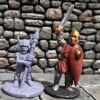Fringe Review: Mazes & Minotaurs from ZDL's blog
Continuing my little experiment in reviewing little-known RPGs, past and present, I'd like to go in a direction directly opposite of my last review. In that I introduced a game that was in all ways completely different from most RPGs that people in the hobby are familiar with. Intead it is, as I put it in a comment, "RPG meets collaborative fiction with a dash of improv".
Today's game is nothing of the sort. It is three perfectly ordinary things:
1. It is a free game and almost militantly so.
2. It is a joke game, or, at least, it started that way.
3. It is a so-called "Old School Rennaisance" game (and arguably the first actual such!).
In 2002, game author and columnist Paul Elliot wrote an article in which he postulates an alternative history where Gary Gygax and Dave Arneson create a game based on Greek miniatures wargaming instead of medieval. This inspired French game author Olivier Legrande to conceive of actually making the game hinted at in that article. In the process of collaboration, the pair, with Legrande doing the bulk of the work, created not only the game Mazes & Minotaurs but also the complicated (and very funny!) joke history around it.
And the joke history is that the game was created by Paul Elliot in 1972 (two years before the publication of Dungeons & Dragons). Assorted supplements that vaguely mirrored the original D&D supplements were created and assigned product release dates two years before their approximate D&D equivalents. Then, in "1987" (two years before the release of Advanced Dungeons & Dragons), Revised Mazes & Minotaurs (RM&M) was released with its mirroring books and from there the game exploded.
As of this writing there are a lot of supplements for M&M. Just go take a look! There's a lot there for what started as a joke game. All of it free.
Production
The game books are written in a breezy style (without the gratuitously grandiloquent vocabulary of the real source materials, thankfully!) and, as part of their affectation of being "reprints" of old editions, have little sidebars expounding on some of the faux-history of the game and its community. Much of it is self-deprecating and a lot of it shines a light on real RPG history in the guise of the fake.
The typesetting of all of it is very basic. A simple decorative frieze-like border surrounds two columns of text and several pieces of clip art that are vaguely thematic. (Well, OK, to be fair, it's more than vague. Legrande has a decent eye for matching such artworks to the text most times.) Font selection is basic as well, although thankfully consistent across the line. Covers range from laughable to decent, though it's unclear how much of this is homage and how much is just the fact it is a free game.
In general, the bottom line is that the game is not made for looks. It's made for play. (And what more do you want from a game that is absolutely, 100% free!?)
Play
And that segues nicely into the most important part of the review: how does this joke game actually play? To review this, I will have to pick an edition, so I will. I will pick the RM&M game, reviewing the rules of that system. (Much of the game is unchanged in the Revised edition anyway, so there's no point in covering both.)
The RM&M rules are in two core rulebooks of 50 pages each, one optional rulebook, also 50 pages, and a 127-page monster book. The first core rulebook, the Players Manual (PM) covers character generation, combat, magic, and adventuring rules.
Character Creation
Character creation is a simple process: for all characters: select a class; roll basic attributes; pick a name and gender, determine age; determine combat scores; determine other scores; determine starting wealth and equipment, purchase extra equipment; flesh out the character.
Character classes are divided into five warrior classes (Amazons, Barbarians, Centaurs, Nobles, Spearmen), five magician classes (Elementalists, Lyrists, Nymphs, Priests, Sorcerers), and two specialist classes (hunters, thieves). All characters start at level 1 and can go to level 6. (It should be noted that the optional Companion adds two extra warrior classes, the Cavalryman and the Archer, as well as a far less sexist Amazon variant.)
There are six attributes: Might, Skill, Wits, Luck, Will, and Grace. These reflect the usual old school game concerns with a slight Greek flavour. 2d6+6 are rolled six times and assigned to attributes. There are some rules around these to keep characters competent. Each class has two primary attributes (e.g. Lyrists have Grace and Luck) and the two highest final values must be allocated to these two attributes. Each attribute comes with a paired modifier by value.
It should be noted that for number-crunchers, Luck is probably the most important of the attributes.
Names are freely decided, and gender is freely decided except for those classes which have pre-decided genders. (Nymphs are always female, for example.) Starting age is 2d6+15 for warriors and specialists, 2d6+20 or magicians. The only exception here is Nymphs, who are ageless.
Combat scores are, as the name would indicate, numbers used in combat and are calculated from attribute modifiers, sometimes with base values added. All but Hits Total incorporate the Luck modifier in addition to other ones, so Luck is an important stat for all-round combatants.
There are four saving rolls: Athletic Prowess, Danger Evasion, Mystic Fortitude, and Physical Vigour. Each character also has a Personal Charisma modifier reflecting interpersonal qualities. There is also an encumbrance total calculated based on a base number plus carried equipment; the impact of this total depends on the Might score directly (not the modifier).
Specialists have talents: Hunting for Hunters, and Thievery for Thieves. Magicians of all kinds have Mystic Strength, Power Points, and a special talent score (like for specialists) which varies by class.
All characters start with reasonable equipment for their class, some basics, and starting money that can be used to buy other things, the amount again depending on their class. In true old school fashion, the equipment list is very basic with mostly representative items and will require extrapolation for items not on it.
Once the mechanical bits are done, players are encouraged to breath life into their characters by supplying a background and personality.
Although an actual, (very!) playable game, the author couldn't resist throwing in some jokes at old school tropes. Every class, for example, has special abilities and some of those are ... ah ... scalpel-sharp parodies of the way things worked in the earlier days. Amazons, for example, use Skill and Grace as their primary attributes and have an ability called "Battle Grace" which adds their Grace modifier to their Defence Class. But this only applies if they're not wearing a breastplate... Yes, you read that right: Amazons get a bonus to their defence based on how good they look, but only if they don't cover up. I'd be offended if I weren't laughing so loudly. This is a wonderful stab at old-school game sexism! Even outside of the interspersed faux-retrospectives the game is loaded with little jokes like that (which is grist for the mill of more jokes in the Companion!).
Combat
Combat is straightforward. Combat is broken into ~6 second battle rounds, each off which has four phases: Decision, Missile, Movement, and Melee. The decision phase has characters announcing their actions in ascending initiative order. Missile attacks are then resolved in descending initiative order. Movement is presumed to occur simultaneously. Finally melee attacks are resolved again in descending order. Surprise takes surprised parties out of the sequence for one entire round and modifies defence values for defences that require awareness (like shield use).
Attacks are rolled on 1d20, adding appropriate modifiers and if equalling or exceeding the opponent's modified defence class, the attack has succeeded and the opponent takes 1d6 of damage. All standard weapons cause 1d6 damage. Some special weapons or spells may use different dice, but a spear and a dagger both do 1d6. Where weapons differ is chiefly in style (role-playing). Characters reduced to 0 hits or less are incapacitated and in danger of dying. Certain kinds of injuries can result in permanent effects. Healing is slow by nature, fast by magic.
There are a variety of special tactics usable by some or all classes: charging into battle, holding back, shield walls, subterfuge, twin-weapons, parrying, close quarters, mounted combat, sneak attacks, etc. This is the other dimension where weapons will differ; it behooves people to know the rules to know the weapons they should carry. There's also a section on unarmed combat--pugilism and wrestling--which the "retrospective" notes claim that very few players took interest in. (A stab at AD&D's convoluted unarmed combat rules, no doubt!)
An interesting mechanism is that warriors and specialists pick a "weapon of choice" (one of daggers, swords, spears, and barbarian weapons) and have "advantage" when using them. "Advantage" involves rolling the d20 twice and choosing the highest value, making use of weapons of choice a valuable thing.
Magic
Magic works in a strange combination of original D&D and AD&D. There are five Realms (Divine, Elemental, Nature, Poetic, Sorcery), each giving access to six magical powers of increasing power. Each power is ranked by "magnitude level" which represents not what character level is needed to wield, but rather how many power points they must spend. All magicians have access to all powers in their Realm if they have the power points to apply. Each realm has a matching magical talent (Priests, for example have Spiritual Aura) which is essentially a casting modifier for using powers. Magicians also hvae mystic strength which drives how effective the impact of a power will be.
Magicians don't get a lot. There are six magic powers in each realm, and a very powerful magician might get 20 power points: enough to use the most powerful abilities three times. That being said, the powers they do command can be very strong and, as such, magicians can form a very powerful "heavy weapons" component in a party. Entering a maze without a magician would be folly. Magicians working alone would be an equal folly.
Adventuring
This part contains the usual rules for travel, movement, environmental perils, and other general adventuring things like stealth or such. One running gag that started in the original edition and has carried on through everything until a whole supplement was dedicated to it is that the sailing rules are terrible. (I can't possibly imagine which game they're making fun of here...) Additionally the rules for NPC reactions, followers, and character advancement are found in this section. Of note is that character advancement is more Chivalry & Sorcery than Dungeons & Dragons: different types of characters collect adventure points differently. Warriors gather Glory for vanquishing foes and accomplishing heroic deeds. Magicians get Wisdom from vanquishing mystical foes and exploring the unknown. That sort of thing. Collect enough of these and characters go up in level, gaining new powers, new abilities, better modifiers and all the other, usual old-school concerns.
Other Books
The bulk of the actual rules of the game fall in the PM. The rest of the books are more about the setting and advice on running the game. The Maze Masters Guide (MMG), the second core rule book, for example, covers Mythic Lore (geography, cosmogony, history, etc.), Creatures (how they're rated, special rules in combat, how to build them, etc.), Game Mastering (how to create adventures, right down to an extensive suite of rather good random generators for that purpose!), and finally Mythic Items (magic loot!).
For jokes, some of the faux-history points out what motivated key design changes (references to killer mice) and there's a beautiful take-down of the infamous Dark Dungeons tract from Chick Publications called Maleficious Mazes which tells the same story with a ... darker bent.
None of what's in the MMG is ground-breaking, but it is good quality material. It is clear that actual thought went into the design of this game; it was intended to be played as well as the source of a large number of good jokes.
The third core book is the Creature Compendium (CC) and is, as the name would suggest, a collection of pre-fabbed monsters. As with the books being imitated, the quality of the monsters ranges from the sublime (Atlanteans are chilling opposition!) to the ludicrous (Tragic Floating Head -- no, really!). There's 230 or so creatures in here and most of them are quite usable. Some of the jokes include a quote from an old "letters column" that derides the "flying eye" as a monster nobody could ever take seriously...
The final core book is entirely optional, containing rules that are not necessarily going to be adopted into every campaign. There are character options, including background talents (yay!) and alternate/extra classes--most notably a far less sexist Amazon. (Which, of course, had to be joked about.) The possibility of characters being Divine Agents is floated, and a large number of combat options are added. (Too many for my tastes, hence "optional" thankfully, although chariot rules are nice to have.) Magic adds the Beastmaster class, as well as optional "elements" of Light and Dark. Religion is expanded upon in a large way (but again, too complicated for my tastes, ... but I've never really had a lot of time for religion when playing RPGs so that's likely just a bias on my part).
One thing added in the CC that is surprisingly good is a set of rules for warfare. The rules are really quite nice, existing somewhere between a full-blown miniatures system (like in the Chivalry & Sorcery Companion) and a simplistic pen and paper system (like in the Chivalry & Sorcery Companion 2). For me these rules hit a sweet spot permitting characters to get involved in (and influence) on the large scale while still being a role-playing game, not a strategic board game in disguise.
Observations
M&M is clearly a joke. Indeed it is a very good joke. But it is more than that. It is a game that reimagines the history of role-playing games and supplies a world that might have been. It is also a game that supplies the charm of old school gaming (rather missing in a lot of modern games) while looking back on almost 25 years of design experience, giving a game that feels like the old-school D&D without the ugly, convoluted, broken bits.
And it did this before "OSR" was a thing.
Honestly, I love this game. I would reach for it over almost any other for quick pick-up games with players of "normal" RPGs. It has that essence that the older games had that were lost by a lot of joyless mid- and latter-generation games, but it has that essence without being screamingly incoherent. This game has a special place in my heart and I encourage anybody reading this review to go grab a copy (did I mention it's free enough?) and give it a try. The worst thing that can happen is you wasted a fraction of a cent on the download, after all.
Today's game is nothing of the sort. It is three perfectly ordinary things:
1. It is a free game and almost militantly so.
2. It is a joke game, or, at least, it started that way.
3. It is a so-called "Old School Rennaisance" game (and arguably the first actual such!).
So why am I reviewing a game so ordinary? Because, naturally, it is in no way ordinary!
In 2002, game author and columnist Paul Elliot wrote an article in which he postulates an alternative history where Gary Gygax and Dave Arneson create a game based on Greek miniatures wargaming instead of medieval. This inspired French game author Olivier Legrande to conceive of actually making the game hinted at in that article. In the process of collaboration, the pair, with Legrande doing the bulk of the work, created not only the game Mazes & Minotaurs but also the complicated (and very funny!) joke history around it.
And the joke history is that the game was created by Paul Elliot in 1972 (two years before the publication of Dungeons & Dragons). Assorted supplements that vaguely mirrored the original D&D supplements were created and assigned product release dates two years before their approximate D&D equivalents. Then, in "1987" (two years before the release of Advanced Dungeons & Dragons), Revised Mazes & Minotaurs (RM&M) was released with its mirroring books and from there the game exploded.
As of this writing there are a lot of supplements for M&M. Just go take a look! There's a lot there for what started as a joke game. All of it free.
Production
The game books are written in a breezy style (without the gratuitously grandiloquent vocabulary of the real source materials, thankfully!) and, as part of their affectation of being "reprints" of old editions, have little sidebars expounding on some of the faux-history of the game and its community. Much of it is self-deprecating and a lot of it shines a light on real RPG history in the guise of the fake.
The typesetting of all of it is very basic. A simple decorative frieze-like border surrounds two columns of text and several pieces of clip art that are vaguely thematic. (Well, OK, to be fair, it's more than vague. Legrande has a decent eye for matching such artworks to the text most times.) Font selection is basic as well, although thankfully consistent across the line. Covers range from laughable to decent, though it's unclear how much of this is homage and how much is just the fact it is a free game.
In general, the bottom line is that the game is not made for looks. It's made for play. (And what more do you want from a game that is absolutely, 100% free!?)
Play
And that segues nicely into the most important part of the review: how does this joke game actually play? To review this, I will have to pick an edition, so I will. I will pick the RM&M game, reviewing the rules of that system. (Much of the game is unchanged in the Revised edition anyway, so there's no point in covering both.)
The RM&M rules are in two core rulebooks of 50 pages each, one optional rulebook, also 50 pages, and a 127-page monster book. The first core rulebook, the Players Manual (PM) covers character generation, combat, magic, and adventuring rules.
Character Creation
Character creation is a simple process: for all characters: select a class; roll basic attributes; pick a name and gender, determine age; determine combat scores; determine other scores; determine starting wealth and equipment, purchase extra equipment; flesh out the character.
Character classes are divided into five warrior classes (Amazons, Barbarians, Centaurs, Nobles, Spearmen), five magician classes (Elementalists, Lyrists, Nymphs, Priests, Sorcerers), and two specialist classes (hunters, thieves). All characters start at level 1 and can go to level 6. (It should be noted that the optional Companion adds two extra warrior classes, the Cavalryman and the Archer, as well as a far less sexist Amazon variant.)
There are six attributes: Might, Skill, Wits, Luck, Will, and Grace. These reflect the usual old school game concerns with a slight Greek flavour. 2d6+6 are rolled six times and assigned to attributes. There are some rules around these to keep characters competent. Each class has two primary attributes (e.g. Lyrists have Grace and Luck) and the two highest final values must be allocated to these two attributes. Each attribute comes with a paired modifier by value.
It should be noted that for number-crunchers, Luck is probably the most important of the attributes.
Names are freely decided, and gender is freely decided except for those classes which have pre-decided genders. (Nymphs are always female, for example.) Starting age is 2d6+15 for warriors and specialists, 2d6+20 or magicians. The only exception here is Nymphs, who are ageless.
Combat scores are, as the name would indicate, numbers used in combat and are calculated from attribute modifiers, sometimes with base values added. All but Hits Total incorporate the Luck modifier in addition to other ones, so Luck is an important stat for all-round combatants.
There are four saving rolls: Athletic Prowess, Danger Evasion, Mystic Fortitude, and Physical Vigour. Each character also has a Personal Charisma modifier reflecting interpersonal qualities. There is also an encumbrance total calculated based on a base number plus carried equipment; the impact of this total depends on the Might score directly (not the modifier).
Specialists have talents: Hunting for Hunters, and Thievery for Thieves. Magicians of all kinds have Mystic Strength, Power Points, and a special talent score (like for specialists) which varies by class.
All characters start with reasonable equipment for their class, some basics, and starting money that can be used to buy other things, the amount again depending on their class. In true old school fashion, the equipment list is very basic with mostly representative items and will require extrapolation for items not on it.
Once the mechanical bits are done, players are encouraged to breath life into their characters by supplying a background and personality.
Although an actual, (very!) playable game, the author couldn't resist throwing in some jokes at old school tropes. Every class, for example, has special abilities and some of those are ... ah ... scalpel-sharp parodies of the way things worked in the earlier days. Amazons, for example, use Skill and Grace as their primary attributes and have an ability called "Battle Grace" which adds their Grace modifier to their Defence Class. But this only applies if they're not wearing a breastplate... Yes, you read that right: Amazons get a bonus to their defence based on how good they look, but only if they don't cover up. I'd be offended if I weren't laughing so loudly. This is a wonderful stab at old-school game sexism! Even outside of the interspersed faux-retrospectives the game is loaded with little jokes like that (which is grist for the mill of more jokes in the Companion!).
Combat
Combat is straightforward. Combat is broken into ~6 second battle rounds, each off which has four phases: Decision, Missile, Movement, and Melee. The decision phase has characters announcing their actions in ascending initiative order. Missile attacks are then resolved in descending initiative order. Movement is presumed to occur simultaneously. Finally melee attacks are resolved again in descending order. Surprise takes surprised parties out of the sequence for one entire round and modifies defence values for defences that require awareness (like shield use).
Attacks are rolled on 1d20, adding appropriate modifiers and if equalling or exceeding the opponent's modified defence class, the attack has succeeded and the opponent takes 1d6 of damage. All standard weapons cause 1d6 damage. Some special weapons or spells may use different dice, but a spear and a dagger both do 1d6. Where weapons differ is chiefly in style (role-playing). Characters reduced to 0 hits or less are incapacitated and in danger of dying. Certain kinds of injuries can result in permanent effects. Healing is slow by nature, fast by magic.
There are a variety of special tactics usable by some or all classes: charging into battle, holding back, shield walls, subterfuge, twin-weapons, parrying, close quarters, mounted combat, sneak attacks, etc. This is the other dimension where weapons will differ; it behooves people to know the rules to know the weapons they should carry. There's also a section on unarmed combat--pugilism and wrestling--which the "retrospective" notes claim that very few players took interest in. (A stab at AD&D's convoluted unarmed combat rules, no doubt!)
An interesting mechanism is that warriors and specialists pick a "weapon of choice" (one of daggers, swords, spears, and barbarian weapons) and have "advantage" when using them. "Advantage" involves rolling the d20 twice and choosing the highest value, making use of weapons of choice a valuable thing.
Magic
Magic works in a strange combination of original D&D and AD&D. There are five Realms (Divine, Elemental, Nature, Poetic, Sorcery), each giving access to six magical powers of increasing power. Each power is ranked by "magnitude level" which represents not what character level is needed to wield, but rather how many power points they must spend. All magicians have access to all powers in their Realm if they have the power points to apply. Each realm has a matching magical talent (Priests, for example have Spiritual Aura) which is essentially a casting modifier for using powers. Magicians also hvae mystic strength which drives how effective the impact of a power will be.
Magicians don't get a lot. There are six magic powers in each realm, and a very powerful magician might get 20 power points: enough to use the most powerful abilities three times. That being said, the powers they do command can be very strong and, as such, magicians can form a very powerful "heavy weapons" component in a party. Entering a maze without a magician would be folly. Magicians working alone would be an equal folly.
Adventuring
This part contains the usual rules for travel, movement, environmental perils, and other general adventuring things like stealth or such. One running gag that started in the original edition and has carried on through everything until a whole supplement was dedicated to it is that the sailing rules are terrible. (I can't possibly imagine which game they're making fun of here...) Additionally the rules for NPC reactions, followers, and character advancement are found in this section. Of note is that character advancement is more Chivalry & Sorcery than Dungeons & Dragons: different types of characters collect adventure points differently. Warriors gather Glory for vanquishing foes and accomplishing heroic deeds. Magicians get Wisdom from vanquishing mystical foes and exploring the unknown. That sort of thing. Collect enough of these and characters go up in level, gaining new powers, new abilities, better modifiers and all the other, usual old-school concerns.
Other Books
The bulk of the actual rules of the game fall in the PM. The rest of the books are more about the setting and advice on running the game. The Maze Masters Guide (MMG), the second core rule book, for example, covers Mythic Lore (geography, cosmogony, history, etc.), Creatures (how they're rated, special rules in combat, how to build them, etc.), Game Mastering (how to create adventures, right down to an extensive suite of rather good random generators for that purpose!), and finally Mythic Items (magic loot!).
For jokes, some of the faux-history points out what motivated key design changes (references to killer mice) and there's a beautiful take-down of the infamous Dark Dungeons tract from Chick Publications called Maleficious Mazes which tells the same story with a ... darker bent.
None of what's in the MMG is ground-breaking, but it is good quality material. It is clear that actual thought went into the design of this game; it was intended to be played as well as the source of a large number of good jokes.
The third core book is the Creature Compendium (CC) and is, as the name would suggest, a collection of pre-fabbed monsters. As with the books being imitated, the quality of the monsters ranges from the sublime (Atlanteans are chilling opposition!) to the ludicrous (Tragic Floating Head -- no, really!). There's 230 or so creatures in here and most of them are quite usable. Some of the jokes include a quote from an old "letters column" that derides the "flying eye" as a monster nobody could ever take seriously...
The final core book is entirely optional, containing rules that are not necessarily going to be adopted into every campaign. There are character options, including background talents (yay!) and alternate/extra classes--most notably a far less sexist Amazon. (Which, of course, had to be joked about.) The possibility of characters being Divine Agents is floated, and a large number of combat options are added. (Too many for my tastes, hence "optional" thankfully, although chariot rules are nice to have.) Magic adds the Beastmaster class, as well as optional "elements" of Light and Dark. Religion is expanded upon in a large way (but again, too complicated for my tastes, ... but I've never really had a lot of time for religion when playing RPGs so that's likely just a bias on my part).
One thing added in the CC that is surprisingly good is a set of rules for warfare. The rules are really quite nice, existing somewhere between a full-blown miniatures system (like in the Chivalry & Sorcery Companion) and a simplistic pen and paper system (like in the Chivalry & Sorcery Companion 2). For me these rules hit a sweet spot permitting characters to get involved in (and influence) on the large scale while still being a role-playing game, not a strategic board game in disguise.
Observations
M&M is clearly a joke. Indeed it is a very good joke. But it is more than that. It is a game that reimagines the history of role-playing games and supplies a world that might have been. It is also a game that supplies the charm of old school gaming (rather missing in a lot of modern games) while looking back on almost 25 years of design experience, giving a game that feels like the old-school D&D without the ugly, convoluted, broken bits.
And it did this before "OSR" was a thing.
Honestly, I love this game. I would reach for it over almost any other for quick pick-up games with players of "normal" RPGs. It has that essence that the older games had that were lost by a lot of joyless mid- and latter-generation games, but it has that essence without being screamingly incoherent. This game has a special place in my heart and I encourage anybody reading this review to go grab a copy (did I mention it's free enough?) and give it a try. The worst thing that can happen is you wasted a fraction of a cent on the download, after all.
















The Wall